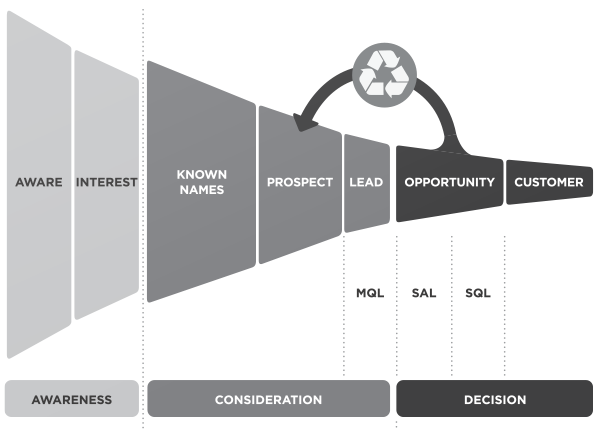Demand generation
Mind the gap: 5 simple steps to marketing and sales alignment
It’s time to adapt to more complex customer behavior.
Intro
The relationship between marketing and sales isn’t always smooth sailing. Sales will blame marketing for generating poor quality leads, and marketers will say the follow-up is lacking. Let’s stop the childish finger-pointing and break down the barriers: time for marketing and sales to join forces.
In most B2B companies, there seems to be an age-old feud between the sales and marketing department. Salespeople and marketers hardly talk to each other, and when they do, the conversation tends to get a liiittle tense.
Sound familiar? Although complaining about your colleagues is definitely one of the biggest perks of daily working life, this silo mentality sure isn’t helping your company along. In fact, sales and marketing misalignment is the biggest reason why annual revenue stagnates or, worse, declines.
So, a long-lasting love story between sales and marketing is crucial to your organisation’s success. These are the 5 steps to marketing and sales alignment.
1. Work towards a common goal
In every relationship, defining common goals is a key element to making things work out. Some people start a family, adopt a cat or engage in hobbies like dance classes or cheese making courses. Working toward a common goal is also an important part of the relationship between marketing and sales.
So, start thinking about lead generation as a joint responsibility. Together, you need to develop a strategy to generate leads that fit your target profile. Which prospects do we want to target? By talking to sales about the lead requirements, your marketing team can figure out the right criteria and develop a strategy to attract qualified customers.
In a B2B marketing environment, the BANT-model provides a solid framework to think about which leads qualify for sales.
- Budget: Does the lead have the budget to buy your product or solution?
- Authority: Does the lead have the authority to make a purchase decision?
- Needs: What business pain points does your service or product reduce?
- Timeline: When is the lead looking to make a purchase?
2. Work out common KPIs that show alignment
Defining a common goal is also about defining common metrics. However, in a lot of companies, the marketing and sales departments have different KPIs, which inevitably leads to differing interests and different views.
The second step to achieving marketing and sales alignment is to harmonise these metrics, or to come up with a new set of metrics that reflects common goals. Possible KPIs to track are:
- MQL to SQL conversion ratio: the percentage of marketing qualified leads that get converted to sales qualified leads
- Opportunity to customer ratio: the percentage of marketing-generated opportunities that converts to customers
- End-to-end conversion ratio: the sum of different conversion ratios across the full sales cycle, from the awareness stage to the brand loyalty stage
These are all important KPIs that track your customer throughout the entire buyer’s journey and provide you with a clear insight into the quality of leads. By keeping track of these metrics, you can tell whether there is a gap in your buyer’s journey and how you can fix it. Looking for more ideas about which KPIs to choose? This guide is a good place to start.
3. Harmonise the buyer’s journey
The next step is harmonising the buyer’s journey. In companies that struggle to align their marketing and sales departments, customers often experience an unsynchronised brand experience. They receive mixed messages throughout the sales funnel and the tone of voice isn’t on point.
To create a holistic customer experience, you need to harmonise the customer journey. First, you need to get a 360-degree view of your customer. A CRM software system is one of the most effective technologies to get clear idea of what your customer wants. The right CRM tool will help you draw the bridge between the marketing data about a prospect and their transformation into leads and opportunities.

4. Follow up leads – together
Just like defining your target audience is a common marketing and sales responsibility, following up leads is a shared activity as well. How to do that? Just talk to each other. The marketing department needs to find out what happens to their leads after they’ve reined them in. And sales needs to provide constructive feedback to marketing at every step of the sales cycle. When marketing gives them leads that aren’t sales-ready, they need to hand them back so marketing can develop a lead nurturing path to reign them in.
Closed-loop reporting can help you evaluate the quality of the leads and adapt your marcom strategy if necessary. It’s also a necessary step in developing a lead nurturing process. By following up leads together, both marketing and sales continuously get to know the customer in a better way. That way, you can tweak your targeting and message throughout the marketing and sales funnel and provide prospects with the right content at the right time.
5. Keep up customer retention
In the past, managing customer relations was primarily a sales responsibility (and if things went really bad, a customer service job). But why not involve you marketing team? Your company could benefit a lot. Just a five percent increase in customer retention has been reported to increase profits by 25-95%.
Marketing shouldn’t just focus on generating leads, but also on nurturing customer relationships with specific messaging. Whether your goal is up-selling or cross-selling, with the right push at the right moment, you can turn one-time buyers into lifelong customers.
There is no 'I' in team
Companies that invest in teamwork, gain more. More agility, more knowledge and eventually – more revenue. By defining a common goal and KPIs, harmonising the buyer’s journey, following up leads and keeping up customer retention together, sales and marketing can overcome their differences and work together as a team. When they follow these 5 steps to sales and marketing alignment, companies transcend their limits and drive growth.
